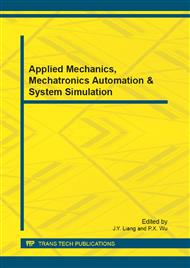p.1554
p.1560
p.1569
p.1573
p.1578
p.1583
p.1588
p.1594
p.1599
A Combined Fair Resource Scheduling and Adaptive Modulation Scheme for Clustered OFDMA Systems
Abstract:
Orthogonal frequency division multiple access (OFDMA) is a promising technique for achieving high downlink capacities in next generation wireless communication system. An OFDM system has the advantage that multiple users can be scheduled at the same time in a frequency-selective channel. Proportional fair resource scheduling algorithm can guarantee the fairness among multiple users. Compared to the conventional fixed modulation, link adaptation modulation can select the most appropriate modulation scheme on each sub-carrier according to the current link qualify, this can be used to enhance system throughput. However, the overhead cost of feeding back channel state and modulation mode information of every sub-carrier for every user is very high. Cluster feedback scheme can greatly reduce the feedback overhead. In this paper, based on cluster feedback, an adaptive modulation with proportional fair scheduling algorithm is proposed. The analysis and simulation result verify that the introduced scheme is effective in improving system throughput and has fairness among users.
Info:
Periodical:
Pages:
1578-1582
Citation:
Online since:
September 2012
Authors:
Keywords:
Price:
Сopyright:
© 2012 Trans Tech Publications Ltd. All Rights Reserved
Share:
Citation:


